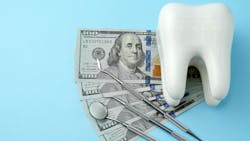Is the profession struggling? ADA study reveals dentists’ revenue, net income, and hours worked in 2025
The ADA Health Policy Institute has recently released new data on economic trends and workplace statistics for 2025. The information was gathered from multiple sources, including the Health Policy Institute's 2025 Survey of Dental Practice.
This data provides an insight into how the dental industry is faring amidst an uptick in unemployment and a higher cost of living; the current economic state is volatile, with many working Americans struggling to make ends meet and a financial downturn portending a potential recession.1 How heavily are dentists and their practices being affected nationwide? What can this year-end data potentially indicate?
Below is a summary of the key findings from the ADA's study to help you better understand the economic state of dentistry right now.
Income lowering but gender gap narrowing
This year, the net income for general practitioner (GP) dentists as well as other health-care professionals has decreased due to high practice expenses and lower revenue.
Data taken from the ADA and US Bureau of Labor Statistics show a steady decline in both average and median net income over the past 14 years (adjusted for inflation), with the average income rounding out to $207,980 in 2024. GP dentists five years out from graduation typically make $166,676 a year.
Despite this, the gender gap in the dental industry is narrowing; in 2024, a male dentist averaged $222,158 while the typical female dentist made $181,194.
The income gap between owner and nonowner dentists has also narrowed over the past five years, with owners netting $217,781 and nonowners netting $160,891 in 2024 respectively.2
Expenses up, revenue down
Expenses are on the rise, but revenue has decreased slightly, which is partly responsive for the downward trend in GP net incomes.
Data collected from 2015 to 2019 and 2020 to 2024 show a 1.2% decrease in revenue ($706,966 to $698,436), 3% increase in expenses per dentist ($468,459 to $482,343) and 13.2% decrease in income ($230,353 to $200,000).
Although both rural and urban areas experienced a drop in median annual income, it was slightly less for rural GP dentists. Revenue is also higher in rural areas, increasing by 6.1% as shown by data collected between 2015 and 2019 vs. 2020 to 2024. Conversely, revenue fell by 1.2% in urban areas during this time period.2
Working overtime to stay afloat
Generally, dentists are making less money but working more hours, with newer dentists putting in the most amount of time in the office compared to GPs with more experience. Between 2010 and 2019, dentists worked 35 hours a week, which has now increased to 36.2 (from data gathered between 2021 and 2024).
The gender gap in hours worked has almost completely evened out; female dentists are now working 98% as many hours per week as their male counterparts. This number was 94% in 2010.
Owner dentists also work more than employee/associate dentists, their hours averaging 37 and 31.8 per week in 2024.2
Conclusion
Overall, American dentists have been stretched thin this year due to a myriad of factors, including higher cost of supplies and lower income, which necessitates more hours in the office. Although dentists are not as well off as they were 10 years ago, progress is still being made as both the gender wage gap and owner/nonowner gap continues to narrow. What 2026 has in store is largely dependent on the future of America's economy.
Review the full scope of the ADA's findings.
References
-
Dutta M. The US economy's 7 deadly signs. Business Insider. November 23, 2025. https://www.businessinsider.com/recession-signs-industries-downturn-layoffs-unemployment-real-estate-restaurants-2025-11
-
Trends in dentists' income, revenue, and hours worked. American Dental Association. November 21, 2025. https://www.ada.org/resources/research/health-policy-institute/dental-practice-research/trends-in-dentist-income
About the Author

Sarah Butkovic, MA, BA
Sarah Butkovic, MA, BA, is an Associate Editor at Endeavor Business Media, where she works on creating and editing engaging and informative content for today's leading online dentistry publications. She holds a Master's English Language and Literature from Loyola University Chicago and is passionate about producing high-quality content that educates, inspires, and connects with readers.
